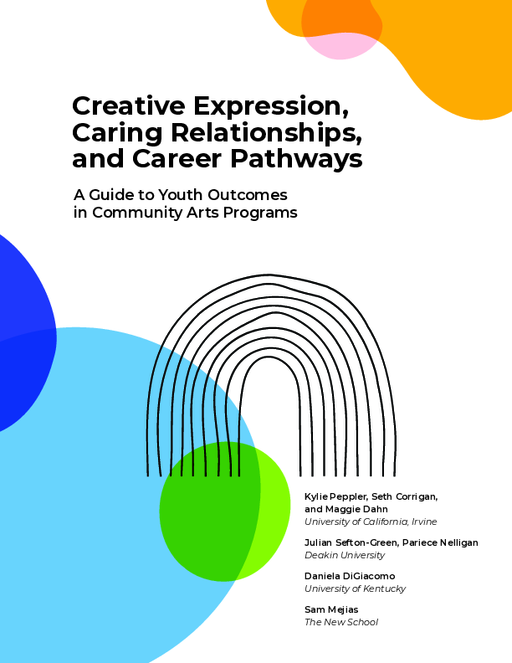Breadcrumb
- Wallace
- Reports
- Creative Expression, Caring Rela...
Creative Expression, Caring Relationships, and Career Pathways
A Guide to Youth Outcomes in Community Arts Programs

- Author(s)
- Kylie Peppler, Seth Corrigan, Maggie Dahn, Julian Sefton-Green, Pariece Nelligan, Daniela DiGiacomo, and Sam Mejias
- Publisher(s)
- University of California, Irvine
Summary
How we did this
The research team surveyed 247 alumni of 32 arts organizations in the United States, United Kingdom, and Australia, representing a range of different arts disciplines, geographic locations, and student populations. Of those who responded to the survey, 102 were chosen for in-depth life history interviews with broad, open-ended questions about their experiences in the programs. Interviewees were an average of 10 years removed from their time in the programs when they were 14 to 24 years old.
Community-based youth arts programs have been shown to provide important, engaging, and empowering experiences for young people. But often, when asked to demonstrate their impact, programs must rely on the anecdotal experiences of participants in their particular program.
An international collaboration of researchers (from Australia, the United Kingdom, and the United States) set out to document how young people engage across these programs and what the lasting effects might be for them. The team spoke with alumni of community-based arts programs. They also held workshops with community-based youth arts program leaders to sort through people’s responses and develop “a taxonomy” of outcomes. The tool also points to program design features that support the different outcomes.
What is the Taxonomy and How is it Used?
Two main themes emerged from the researchers' interviews, which became the basis for two main categories in the taxonomy:
- Relational outcomes, which shape how arts program participants interact with peers and mentors and come to understand themselves, their community, and their environment. For example, nearly everyone interviewed said their participation in arts programs helped them build enduring friendships and grow as people.
- Opportunity outcomes, which are the ways arts programs help young people envision adulthood and pursue careers. These include the development of workplace skills and exposure to cultural and educational resources that highlight potential careers and other opportunities for young people.
These two main categories break down into a series of sub-categories and outcomes that youth may achieve through program participation. The researchers present them in the report along with program design elements that supported them.
The taxonomy seeks to move beyond the short-term measurements like attendance that have been common in arts programs. It will allow practitioners and others to capture less quantifiable effects like forming close ties with others or developing self confidence.
The taxonomy can be used to:
- Guide program design and improvement to ensure that arts organizations are structuring their programs with elements that are linked to the long-term outcomes they want to achieve
- Make useful comparisons to other programs so that organizations can zero in on the outcomes and approaches that fit their community's needs
- Advocate for increased recognition and support by demonstrating the full value of these programs to funders and policymakers
- Broaden the types of outcomes that arts organizations and funders track, including attendance, behavior change, and skill acquisition as well as less commonly documented benefits like interpersonal growth, identity formation, and personal agency

When it was time to start to apply to college, my Dance Teaching Artist asked me if I was considering going to college for dance…this one question…changed my life and led me down a path to become a professional dancer and then dance educator.
— Participant in youth program
Key Takeaways
- Community arts programs help young people build rewarding relationships and offer a safe space to learn about who they are or may want to be while expressing themselves without fear of judgement.
- Not only do arts programs help young people discover the joy of art-making, they also prepare them for success in school and beyond, providing exposure to new career opportunities and future trajectories.
- The new taxonomy is a tool that can be used to classify the ways community arts programs affect youth’s long-term well-being.
- The taxonomy can support program design by showing arts leaders specific program features that make outcomes possible.
Materials & Downloads
What We Don't Know
- Researchers interviewed individuals with continuing connections with programs, which could mean that the results reported reflect only those who clearly had positive program experiences. Interviews with participants who did not maintain relationships with the programs might reveal additional or confounding types of impacts.
- Given the open-ended nature of the interviews, there may be outcomes that are not included because interviewees didn’t mention them. Further research may be able to expand on the taxonomy of outcomes.

